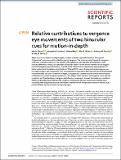Files in this item
Relative contributions to vergence eye movements of two binocular cues for motion-in-depth
Item metadata
| dc.contributor.author | Giesel, Martin | |
| dc.contributor.author | Yakovleva, Alexandra | |
| dc.contributor.author | Bloj, Marine | |
| dc.contributor.author | Wade, Alex R. | |
| dc.contributor.author | Norcia, Anthony M. | |
| dc.contributor.author | Harris, Julie | |
| dc.date.accessioned | 2019-11-26T11:30:07Z | |
| dc.date.available | 2019-11-26T11:30:07Z | |
| dc.date.issued | 2019-11-22 | |
| dc.identifier | 262927137 | |
| dc.identifier | 50e64162-7aec-44bf-926d-20427bacea9b | |
| dc.identifier | 85075499688 | |
| dc.identifier | 000498057100003 | |
| dc.identifier.citation | Giesel , M , Yakovleva , A , Bloj , M , Wade , A R , Norcia , A M & Harris , J 2019 , ' Relative contributions to vergence eye movements of two binocular cues for motion-in-depth ' , Scientific Reports , vol. 9 , 17412 . https://doi.org/10.1038/s41598-019-53902-y | en |
| dc.identifier.issn | 2045-2322 | |
| dc.identifier.other | ORCID: /0000-0002-3497-4503/work/65345209 | |
| dc.identifier.uri | https://hdl.handle.net/10023/19004 | |
| dc.description | Supported by NIH EY018875 (AMN), BBSRC grants BB/M001660/1 (JH), BB/M002543/1 (AW), and BB/MM001210/1 (MB). | en |
| dc.description.abstract | When we track an object moving in depth, our eyes rotate in opposite directions. This type of “disjunctive” eye movement is called horizontal vergence. The sensory control signals for vergence arise from multiple visual cues, two of which, changing binocular disparity (CD) and inter-ocular velocity differences (IOVD), are specifically binocular. While it is well known that the CD cue triggers horizontal vergence eye movements, the role of the IOVD cue has only recently been explored. To better understand the relative contribution of CD and IOVD cues in driving horizontal vergence, we recorded vergence eye movements from ten observers in response to four types of stimuli that isolated or combined the two cues to motion-in-depth, using stimulus conditions and CD/IOVD stimuli typical of behavioural motion-in-depth experiments. An analysis of the slopes of the vergence traces and the consistency of the directions of vergence and stimulus movements showed that under our conditions IOVD cues provided very little input to vergence mechanisms. The eye movements that did occur coinciding with the presentation of IOVD stimuli were likely not a response to stimulus motion, but a phoria initiated by the absence of a disparity signal. | |
| dc.format.extent | 14 | |
| dc.format.extent | 3905319 | |
| dc.language.iso | eng | |
| dc.relation.ispartof | Scientific Reports | en |
| dc.subject | BF Psychology | en |
| dc.subject | DAS | en |
| dc.subject | BDC | en |
| dc.subject.lcc | BF | en |
| dc.title | Relative contributions to vergence eye movements of two binocular cues for motion-in-depth | en |
| dc.type | Journal article | en |
| dc.contributor.sponsor | BBSRC | en |
| dc.contributor.institution | University of St Andrews. Institute of Behavioural and Neural Sciences | en |
| dc.contributor.institution | University of St Andrews. School of Psychology and Neuroscience | en |
| dc.identifier.doi | 10.1038/s41598-019-53902-y | |
| dc.description.status | Peer reviewed | en |
| dc.identifier.grantnumber | BB/M001660/1 | en |
This item appears in the following Collection(s)
Items in the St Andrews Research Repository are protected by copyright, with all rights reserved, unless otherwise indicated.

